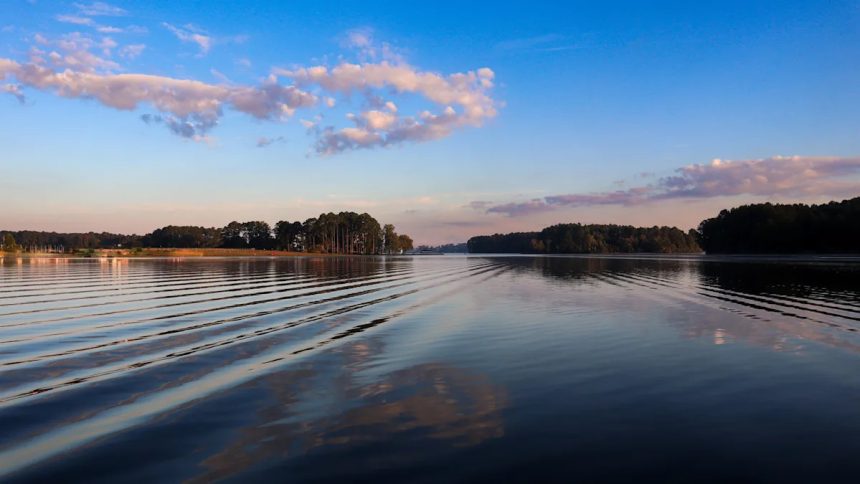For those who love natural beauty, the state of Georgia has some of the best scenery and outdoor spaces in the United States. From the Blue Ridge Mountains in the north to the rugged coastline near Savannah, the Peach State is perfect for all kinds of outdoor activities, especially those involving water.
For example, one of Georgia’s most popular tourist attractions is an easily accessible waterfall hidden near the town of Helen. The state also boasts various lakes and rivers, so it’s easy to find somewhere to swim, boat, kayak, or fish.
Unfortunately, some of these bodies of water may hide some nasty surprises, such as snakes. While a snake encounter isn’t guaranteed to be dangerous or life-threatening, it’s still imperative to understand the risks before getting into an unknown river, creek, lake, or pond. So, with that in mind, let’s look at four of the most snake-heavy lakes and rivers in Georgia so you can plan your outdoor adventure accordingly.
Read more: The 5 Most Alligator-Filled Destinations In All Of Florida
Chattahoochee River
A tree hanging over the Chattahoochee River in Sandy Springs – Ed Williams/Getty Images
The Chattahoochee River is probably the most famous river in Georgia, especially because it weaves through multiple cities, such as Peachtree Corners and Sandy Springs. In fact, Sandy Springs is where you can find a nearby serene bamboo forest that looks like another country, which happens to be situated near the banks of this river.
Overall, the Chattahoochee is a popular destination for outdoor lovers as it offers idyllic scenery, along with swimming, kayaking, boating, and floating opportunities at different points along the riverbanks. Just in the Chattahoochee River National Recreation Area, roughly 3.2 million visitors take advantage of the river every year, particularly during the hottest parts of the summer. But people aren’t the only ones taking to these waters. The river is home to multiple snake species, including corn snakes, water snakes, and king snakes.
That said, the most dangerous species to call the area surrounding the river home are the Timber Rattlesnake and the Copperhead Viper. Both of these snakes are venomous and can cause serious harm if they bite you. Thankfully, though, bites are rarely lethal, assuming you can seek medical attention quickly. So, if you’re venturing into the Chattahoochee next to a major city, you should be able to reach the hospital in time to mitigate any potential complications.
Lake Hartwell

The shore of Lake Hartwell – Stonedkraj/Shutterstock
If you venture out to the northeastern corner of Georgia where it meets South Carolina, you’ll run into Hartwell, a city with a historic square, comfy cabins, and shops. This city is also situated on the shores of Lake Hartwell, which straddles the border between both states. The lake, which was created by the Army Corps of Engineers between 1955 and 1963, holds over 56,000 acres of water and has over 962 miles of shoreline. With so much natural beauty, it only makes sense that Lake Hartwell would also be home to some snakes.
As with the Chattahoochee River, the most dangerous snakes you can find slithering around Lake Hartwell include Timber Rattlesnakes and copperheads, as well as Pygmy Rattlesnakes. Fortunately, they like to hang out wherever people are the most scarce, so if you stick to the main parks, campgrounds, and boating areas, you shouldn’t have to worry about encountering a venomous serpent.
Water snakes are more common because they spend most of their time in the lake. Thankfully, water snakes also tend to avoid boats and humans, so it’s unlikely that one will join you while you’re enjoying the lake. The species most often found in and around Lake Hartwell are the Northern, Brown, and Red-Bellied Water Snakes. All of these species are non-venomous, so if you do happen to see one, you shouldn’t have to worry about making a trip to the emergency room.
Ocmulgee River

Autumnal foliage along the banks of the Ocmulgee River – Norm Lane/Shutterstock
While the Chattahoochee River snakes through the greater Atlanta Metro area, the Ocmulgee River weaves through central and southern Georgia. The best place to experience this river is by visiting the wildly underrated city known as the birthplace of Southern rock, Macon. Alternatively, if you prefer to see the river in a more natural setting, you can head further south to the Ocmulgee Wildlife Management Area or venture to the Ocmulgee Mounds National Park just outside the city.
The area surrounding the mounds houses most of the snakes along the Ocmulgee, likely because the region is protected as a national park. Again, water snake species are the most common, but since they’re non-venomous, you don’t have to worry about getting bitten unless you harass or provoke them.
However, the park is also home to water moccasins and copperheads, so if you’re exploring more remote spots, make sure to keep a sharp eye for these dangerous creatures. These species are much less common further down the river, where you might instead encounter rat and king snakes.
Lake Sinclair

Lake Sinclair at sunrise – Ed Williams/Getty Images
Our final snake-filled body of water is a gorgeous lake getaway situated between Atlanta and Augusta. Like Lake Hartwell, Lake Sinclair is a human-made reservoir, and it’s a popular destination for those who want to go camping, boating, swimming, and fishing. This lake is much smaller, encompassing over 15,000 acres of water, but it’s just as idyllic and serene, particularly during the spring and fall when the weather is the most accommodating.
Fortunately, the snakes you can find in this body of water are almost all non-venomous water snakes, making Lake Sinclair one of the safer options on this list. That said, the entire state of Georgia only experiences a few hundred snakebite cases per year, so the chances of getting bitten are still pretty rare (even though the number is going up slightly).
The only dangerous snake you might come across in Lake Sinclair is the water moccasin, but sightings are quite uncommon in the region. If you do happen to get close to one, it will likely warn you by baring its fangs and opening its jaw, which should hopefully give you enough time to back off and leave it alone.
What to do if you encounter a snake in the wild

A snake in the water – Gayle & Bryan Tapp / 500px/Getty Images
Although snake encounters and bites are rare, they have been steadily increasing in Georgia in recent years, according to the Georgia Poison Center. Various factors, including more people venturing into snake territory, can cause an uptick in incidents, so it’s vital to be careful and knowledgeable when planning your outdoor adventure.
One crucial point to keep in mind is that snakes are generally not aggressive, so they’re not looking for a fight. If you leave a snake alone, it should do the same and likely try to get away from you as quickly as possible. Even if you’re in the water, making noise and splashing the area should ward off any snakes.
No matter what, never try to pick up or interact with a wild snake, even if you think it’s not venomous. Non-venomous snakes still have fangs and can bite, so it’s best to leave them alone. Should the worst happen and you get bitten by a venomous species, call 911. According to the Mayo Clinic, don’t try to remove the venom or capture the snake for identification. Instead, seek treatment as soon as possible. If you can, describe what the snake looked like when getting treated for better results.
Ready to discover more hidden gems and expert travel tips? Subscribe to our free newsletter and add us as a preferred search source for access to the world’s best-kept travel secrets.
Read the original article on Islands.









